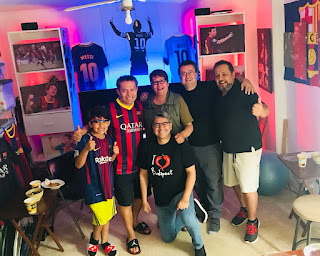 |
| Giving What We Can |
It has now been over a decade since I joined the EA movement. Today, I looked up how much of an effect my donations have made. I was pleasantly surprised to learn that, over the course of the last ten years, my donations toward EA charities have added up to the equivalent of saving the lives of 37 people.
This is pleasing to me on several fronts. First, my go-to favorite number has been 1/137 for many decades at this point, so 37 is just a generally pleasing number for me to see. Second, it helps to make salient just how much my efforts have made a difference. As of 2020, it appears that it costs around $2300 to effectively save the life of a person via AMF. I've accomplished this standard an astonishing 37 times. This is honestly staggering to me.
 |
| Marcos is in the Qatar shirt, posing w/ siblings. |
There's a story that gets told at my family gatherings. It comes up maybe once every few years. It goes like this:
Forty years ago, my uncle Marcos was walking down the street in his home country of Bolivia. He turns a corner, and he is suddenly facing a fire that has recently started raging in a house, only a few tens of meters away. He drops his pack and runs to the house, calling out if anyone is still inside. When he hears a faint voice, he rushes in, zeroes in on the older lady there, and successfully brings her out of the building. Later, firefighters arrive, and they help to partially save the building. But the old woman saves most of her thanks to my uncle Marcos.
When this story is told, people at the dinner table feel pride for what Marcos did that day. He wasn't a firefighter; he was just a bystander who stood up to do what is right when he found himself in a place where he could help save a life. This is a story of a hero, and it feels good to hear it.
But, of course, actual firefighters get the chance to save lives much more often than this. Maybe not as often as it occurs in the movies, but maybe on average they get to save someone's life once a year. They are, without a doubt, even more heroic. Yet I wonder if they get as many positive feels around the dinner table as Marcos does when his story gets retold.
So when I started donating to effective altruism charities in 2011, I made a personal decision that ended up working out very well for me. I decided that instead of giving a monthly donation, I would save up my donations until they reached a certain chunk size, and then I would donate that amount to a single EA charity. The size I chose was the donation size that GiveWell at the time had determined was the amount needed to save a life by donating to the Against Malaria Foundation.
Since then, EA has become more mature. GiveWell no longer likes to talk in terms of "the amount it takes to save a life". But I've kept the tradition of giving in chunks for a very good reason: it makes me feel good.
Every time I donate a block of money that I've saved up, I visualize in my mind that it is me that has dropped my pack, and it is me that is running toward that burning building. I visualize that, as I donate this amount, what is actually happening is that I am saving this specific individual's life.
And you know what? As corny as this sounds, it actually works. It's a private experience — it doesn't get told at family dinners — and it is somewhat mitigated by the fact that I give to EA charities that aren't AMF these days, but it nevertheless feels to me like I am making a difference every time I donate a chunk of money. It works even though I have aphantasia, and I visualize in a completely different way than most people do. It works even though I know the person in my head that I'm saving is not literal/real. It works even though I do this ceremony alone, just for myself, without others to be around to experience or even know about it. It just works, and it honestly makes the experience of giving for charitable utilons to be as pleasurable as when I give for fuzzies. It's a different feeling; it comes less often. But it feels good.
Over time, I've visualized saving someone an astonishing 37 times. It has felt wonderful every single time. (Technically, I've gone through the process fewer times than this, because the old calculation for how much it cost to save a life was $7500. It is now $2300.)
If you have yet to take the Giving What We Can pledge, I strongly encourage you to do so. To date, 8,274 people have taken the pledge. You could be the 8,275th. Of all the things you could purchase with your money, this is perhaps the thing that may ultimately mean the most, and, if you treat it as a ceremony the way that I do, it may also end up feeling like the most wonderfully feeling personal experience that money can honestly buy.
Just calculated that, over the last decade, I've saved the equivalent of 37 lives by donating to #EffectiveAltruism charities, fulfilling a total of 203% of my @givingwhatwecan pledge. Feeling particularly proud of my impact today. (c:https://t.co/rVAlKwSf4S
— Eric Herboso (@EricHerboso) March 14, 2022
No comments:
Post a Comment